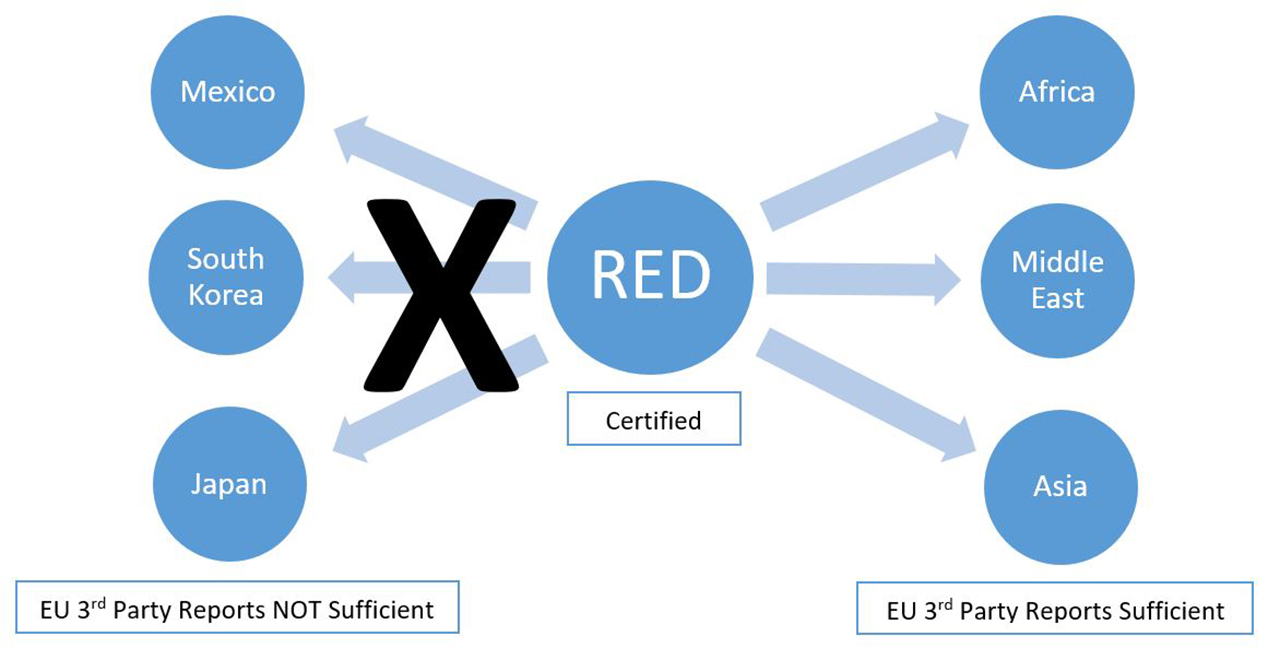随着物联网的日益普及,越来越多的公司希望监控和跟踪其全球资产。许多公司希望能够在全球市场上销售其无线产品。也许您长期以来一直只在北美市场经营,现在您想更进一步,将现有的成功产品推广到欧洲市场。获得全球部署的无线产品认证可能是一个令人生畏的前景。
我们理解。在 Digi,我们用自己的产品完成认证过程,并一直在这个过程中为客户提供支持。例如,我们的
Digi 的 SmartSense 我们的团队与一家大型欧洲客户建立了合作伙伴关系,并面临着将其智能蜂窝网关和传感器套件扩展到欧盟地区销售和运营的挑战。我们做到了。
Digi WDS 在数百家客户希望拓展国际市场时,我们通过全球认证流程为他们提供了支持。我们撰写这篇文章的目的是帮助您建立有关全球蜂窝产品的基本知识,并制定行动计划。我们还可以通过该流程的任何方面满足您的要求。
IoT 产品或部署走向全球
必须明白的一点是,"全球 "并不意味着 "无处不在"。
没有所谓的 "全球认证"。每个产品都必须根据其销售地区的认证要求进行评估,因为不同地区有不同的蜂窝频段、不同的认证机构和不同的要求。未经认证的蜂窝产品在购买国以外的地区可能无法使用,也可能无法在其他地区销售。
走向世界是一个漫长而艰巨的过程,需要与许多规则、表格和政府打交道。因此,一套定义明确的蜂窝产品使用案例将决定 "全球化 "在产品中的含义。
如果贵公司正在开发一种新产品,并设想在全球销售,那么开发团队可以采取以下几个步骤:
- 采取 "小步 快跑 "的方式--选择潜力最大的地区,首先在这些地区重点开发,从而更快地进入市场。首次发布后,在所有其他地区分阶段推广。为不同地区编制认证文件既费时又费钱,因此分阶段推出有助于平衡员工的工作量。
- 避免复杂性 --由于现成的蜂窝无线电产品通常都是具有相同尺寸和外形尺寸的系列产品,因此要重视多 SKU 的托管。 如果多 SKU 路线适合贵公司,最好的办法是针对每个地区开发一套变体。
处理多地区用例
如果产品需要在不同地区之间频繁穿梭(例如在洲际货轮上进行跟踪),那么设计要求就会排除大型 SKU 套件以及在较长时间内分散认证工作的可能性。
需要多地区使用的用例也带来了新的挑战:蜂窝无线电模块必须在运行地区拥有可用频段,这进一步缩小了可用模块的选择范围。无论产品的使用案例是什么,重要的是要具体确定这些使用案例,以便开始进一步的研究和规划。
建议的全球蜂窝产品开发计划
新蜂窝产品的第一天规划应解决三个问题:
- 产品的数据传输速率
- 数据使用
- 业务地区
数据速率和使用量
数据传输速率和使用情况决定了产品的蜂窝类别(Cat)。更高的 Cat 允许以更快的数据传输速率传输更大量的数据。但这样做的代价是更高的功耗和更昂贵的无线电模块。
业务地区
从开发角度看,产品区域极为重要。无线电模块以系列为单位,因此为了简化电路设计和降低成本,最好保持在该系列内。因此,区域选择决定了每个模块制造商的生存能力。
此外,国与国之间也可能存在共同的工作频率,因此设定工作区域可为产品的天线设计开发团队提供参考。
还有无线认证问题。许多地区都有共同的认证测试,因此,选择地区就能切实了解时间表以及需要向监管委员会提交多少文件。例如,美国和加拿大分别颁发 FCC ID 和 IC 编号,但每个认证背后实际上都是同一套测试。 同样,欧盟的《无线电设备指令》(RED)为欧盟制定了测试标准,但其他国家(主要是非洲、亚洲和中东国家)也接受符合 RED 标准的产品。
通过这两项认证的实验室测试,产品就可以在美国和欧盟以外的更多地方销售。但要注意的是,中国、韩国和墨西哥等市场较发达的国家可能会要求在欧盟或 FCC 规定的测试之外进行额外的测试。

设备选择
在解决了数据传输速率、数据使用量和运营地区的问题后,要对现有资源进行评估。将蜂窝产品推向全球市场是巨大的一步,因此在前进之前一定要考虑以下几点:
- 现有产品可以做哪些改进?引入现有产品的变体是进入新地区的一个简单方法。但是,不要从几乎没有文档的现有产品开始--最好从头开始。
- 哪些是现成采购的,哪些是内部开发的?屏蔽罩等组件的尺寸很容易买到,因此为了降低成本,必须将敏感的无线电组件限制在这些尺寸内。天线也是现成的,但如果有合适的专业知识,设计定制天线可能更具成本效益。
- 您是否已做好认证预算?如果要获得 FCC ID 和 CE 标志,仅这两项认证的费用就高达 25,000 美元或更多。这笔费用还不包括提交文件、确保包装正确、使用符合 ISO/IED 17025 标准的测试实验室的测试室以及其他相关费用。失败是常有的事,因此在这种情况下,为设计变更制定计划也很重要。(请注意,Digi WDS通常可以通过确保产品设计符合认证要求来节省这些额外费用。如需了解更多信息,请咨询我们的团队)。
- 您是否具备起草设计验证测试 (DVT) 计划的专业知识? 蜂窝电话市场在全球范围内运作,竞争十分激烈,因此在首次发布产品时就取得成功非常重要。在产品准备发布之前,针对大量新地区的规划增加了测试的数量和 DVT 的复杂性。如果您的工程团队不太熟悉所有不同的认证测试,请咨询当地咨询集团或测试实验室的认证或同质化工程师。
- 您是否为认证预测试预留了时间和资金? 即使是在无线产品方面拥有良好记录的公司,也需要考虑到他们可能无法在第一块电路板上就完成测试。值得一提的还有,天线原型在无人居住的地平面上可以正常工作,但在最终产品上却可能无法正常工作。在 EMC 测试实验室对蜂窝产品进行预测试并不是免费的,但它的成本肯定低于用有问题的电路板和不良数据提交完整的认证包。
- 生产厂如何测试产品? 请注意,如果制造工厂与研发工厂位于不同的国家,那么在产品下线时验证产品质量的难度将大大增加。例如,仅为北美设计但在中国生产的蜂窝产品可能无法在生产线上立即连接到实时网络。由于中国和北美使用不同的 LTE 频段,因此可能无法在生产线上进行实际测试。 因此,最好在供应链和研发部门之间保持畅通的沟通渠道,以便在为时已晚之前解决这些问题。
最后说明
对过去产品的现有文档以及具有设计验证专业知识的人员进行调查,更容易为产品开发设定基准。如果公司内部没有这些资源,则可参考业内领先公司的其他白皮书或聘请咨询公司。
Digi 在 30 多年的互联设备业务中积累了深厚的专业知识。 尽管 SmartSense by Digi 是我们最近进行改造的产品线,但 5G 的兴起让我们重新审视了所有现有的蜂窝产品,并对其进行更新,以实现我们全球组织的目标。
希望进入这一领域的公司必须在其开发团队中拥有熟悉蜂窝技术以及如何将其推向全球的人才。Digi WDS是这一领域的世界级专家。 与 Digi WDS 合作,我们将从您的项目开始到生产和发布全程参与,以确保规划和预算合理,同时避免所有常见错误。